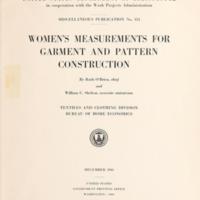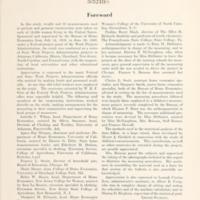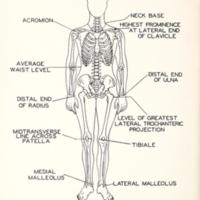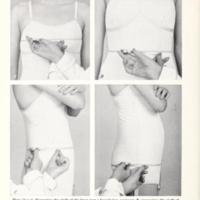Women's Measurements for Garment and Pattern Construction
Title
Women's Measurements for Garment and Pattern Construction
Date
1941
Relation
Miscellaneous Publication Number 454
Subject
Excerpt
This research project was undertaken in order to provide measurements which could be used for improving the fit of women's garments and patterns. No scientific study of body measurements used in the construction of women's clothing has ever been reported. The measurements used have grown up in the industry, apparently chiefly by trial and error, based on measurements taken on a few women by various inaccurate procedures. As a result, there are no standards for garment sizes, and retailers and consumers are subjected to unnecessary expense and harassed by the difficulties involved in obtaining properly fitting clothing.
Garments labeled the same size but made by different manufacturers vary greatly, and few of them fit without alteration. Women often have to add to the price of ready-made clothes large additional sums for alterations. In some cases, these may amount to as much as an additional 25 percent on the cost of a dress. Garments that cannot be fitted and altered where bought are often returned to the store because of wrong size. This means a loss of money and good will to the retailer and annoyance and waste of time to the woman purchaser. Mail-order houses have a large volume of such returns, which add to the cost of merchandise and work a hardship on rural homemakers who frequently must buy by mail.
To be satisfactory, garment and pattern sizing must be based on a practical and logical classification of body types. Therefore this study included not only the measuring of a large group of women, but also a detailed statistical analysis of the results. The latter was so planned as to provide data from which the garment and pattern industry can develop a system of sizes satisfactory to consumers and all branches of the trade. To this end, special attention was given to discovering key measurements of the body; that is, a few important measurements from which all the others can best be predicted.
As is discussed on pages 31 to 41, the analysis showed that girth measurements of the body have little relation to vertical (height) measurements. For example, bust measure, which is often used as a basis for sizing women's dresses, cannot be used to predict the vertical measurements. Women with bust measurements of 46 or 47 inches are no taller, on the average, than those with bust 32. Women 5 feet 9 inches tall have no larger busts, on the average, than those 5 feet tall. A combination of a vertical and a horizontal measurement must be used if all the measurements are to be accurately predicted.
Height seems to be the most practical vertical measurement to use in such a combination. It is the easiest one to take and is as accurate a predictor of other vertical measurements as is any other one measurement. However, no one girth measurement is as good a predictor of the other girths as is weight.
In other words, a stature-weight combination would be the best basis for classifying women's body types for the establishment of a standard system of garment and pattern sizes. Figures for setting up such a system are given in table 18. Data for alternative systems which would not be so generally satisfactory are also included in this report.
Garments labeled the same size but made by different manufacturers vary greatly, and few of them fit without alteration. Women often have to add to the price of ready-made clothes large additional sums for alterations. In some cases, these may amount to as much as an additional 25 percent on the cost of a dress. Garments that cannot be fitted and altered where bought are often returned to the store because of wrong size. This means a loss of money and good will to the retailer and annoyance and waste of time to the woman purchaser. Mail-order houses have a large volume of such returns, which add to the cost of merchandise and work a hardship on rural homemakers who frequently must buy by mail.
To be satisfactory, garment and pattern sizing must be based on a practical and logical classification of body types. Therefore this study included not only the measuring of a large group of women, but also a detailed statistical analysis of the results. The latter was so planned as to provide data from which the garment and pattern industry can develop a system of sizes satisfactory to consumers and all branches of the trade. To this end, special attention was given to discovering key measurements of the body; that is, a few important measurements from which all the others can best be predicted.
As is discussed on pages 31 to 41, the analysis showed that girth measurements of the body have little relation to vertical (height) measurements. For example, bust measure, which is often used as a basis for sizing women's dresses, cannot be used to predict the vertical measurements. Women with bust measurements of 46 or 47 inches are no taller, on the average, than those with bust 32. Women 5 feet 9 inches tall have no larger busts, on the average, than those 5 feet tall. A combination of a vertical and a horizontal measurement must be used if all the measurements are to be accurately predicted.
Height seems to be the most practical vertical measurement to use in such a combination. It is the easiest one to take and is as accurate a predictor of other vertical measurements as is any other one measurement. However, no one girth measurement is as good a predictor of the other girths as is weight.
In other words, a stature-weight combination would be the best basis for classifying women's body types for the establishment of a standard system of garment and pattern sizes. Figures for setting up such a system are given in table 18. Data for alternative systems which would not be so generally satisfactory are also included in this report.
Publisher
U.S. Department of Agriculture. Bureau of Human Nutrition and Home Economics. Division of Textiles and Clothing
 An official website of the United States government.
An official website of the United States government.








